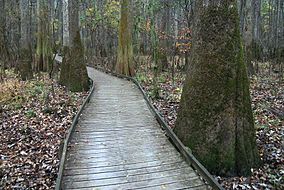South Atlantic Coastal Plain
| Congaree National Park | |
|---|---|
|
IUCN category II (national park)
|
|

Boardwalk passes through old growth forest of bald cypress and water tupelo
|
|
|
Location in the United States
|
|
| Location | Richland County, South Carolina, USA |
| Nearest city | Eastover, South Carolina (town) |
| Coordinates | 33°47′0″N 80°47′0″W / 33.78333°N 80.78333°WCoordinates: 33°47′0″N 80°47′0″W / 33.78333°N 80.78333°W |
| Area | 26,276 acres (106.34 km2) |
| Established | November 10, 2003 |
| Visitors | 143,843 (in 2016) |
| Governing body | National Park Service |
| Website | Congaree National Park |
| Designated | February 2, 2012 |
| Designated | May 1974 |
Congaree National Park preserves the largest tract of old growth bottomland hardwood forest left in the United States. Located in South Carolina, the 26,276-acre (41.06 sq mi; 10,633.52 ha; 106.34 km2) national park received that designation in 2003 as the culmination of a grassroots campaign that started in 1969. The lush trees growing in this floodplain forest are some of the tallest in the Eastern U.S., forming one of the highest temperate deciduous forest canopies remaining in the world. The Congaree River flows through the park. About 57 percent (15,000 acres or 61 square kilometers) of the park is designated wilderness area.
Resource extraction on the Congaree River centered on cypress logging from 1898, when the Santee River Cypress Logging Company began to operate in the area of what is now the park. Owned by the Beidler family of Chicago, the company operated until 1914, after which the Beidlers retained ownership of the area. In the 1950s Harry R.E. Hampton was a member of the Cedar Creek Hunt Club and co-editor of the The State. Hampton joined with Peter Manigault at the Charleston The Post and Courier to advocate preservation of the Congaree floodplain. Hampton formed the Beidler Forest Preservation Association in 1961. As a result of this advocacy a 1963 study by the National Park Service reported favorably on the establishment of a national monument.
No progress was made in the 1960s. Renewed logging by the Beidlers in 1969 prompted the 1972 formation of the Congaree Swamp National Preserve Association (CSNPA). The CSNPA joined forces with the Sierra Club and other conservation organizations to promote federal legislation to preserve the tract. South Carolina Senators Strom Thurmond and Ernest F. Hollings introduced legislation in 1975 for the establishment of a national preserve. On October 18, 1976 legislation was passed to create Congaree Swamp National Monument. An expansion plan was introduced by Hollings and Thurmond in 1988, expanding the monument to 22,200 acres (9,000 ha).
...
Wikipedia


